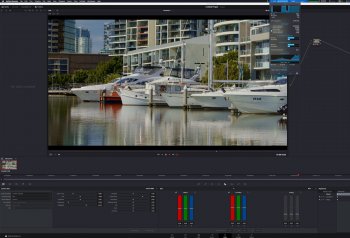What if there's hope in Apple configuring the After Burner card to support these codecs to provide longevity for the Mac Pro...
If that's possible, it would finally give reason to invest in that card.
Apple lowering their RAM upgrade prices to market rates is possible. It is also not likely.
It isn't likely Apple is going to use Afterburner to do a wide variety of codecs. In part, because would have to test which "mode" the card was in before use it. The FPGA in the AfterBurner conceptually means could turn it into a different product if "reprogramming" the gate array elements. But then it wouldn't be a ProRes product anymore.
There are also only a finite number of gates in the FPGA so it is not necessarily going to have huge amounts of "spare" , unused gates that don't currently have something to do in the ProRes configuration.
The other reasons is that the sole path to Afterburner is through Apple foundation libraries.
AfterBurner also only currently does "half" of ProRes. Decode only. It doesn't even encode Apple's own codec.
I'm not sure what kind of get element budget they have to allocate to encode but I'd expect a mode where could split the Afterburner to en/decode ( drop the maximum decode streams in a "trade" for an encode one (e.g. 3 8K decode 0 encode -> 1 8K decode 1 8K encode ) .
If the decode mode doesn't completely disappear then Apple doesn't have to test if the ability is still there. ( may have to test quantity of streams but that test pragmatically needs to be there anyway. Sending 10 8K concurrent streams at Afterburner isn't going to work either even in the default mode. )
Apple really wants the camera folks to license ProRes and put it inside the camera as an optional, "native" mode. ( where "native" means one of the options , not the natural format the camera uses by default. ). Or minimally allow a "RAW output" mode that Atomos (and others ) can use to record to "native" ProRes. ( and somewhat claim it is a "native" mode of the camera when done outside the camera (but completed upstream from the Mac/Windows machine usage of the file). )
Longer term the more general standards , fixed video codecs will get shoveled into the Apple Silicon SoC ( the T2 just happens to be a bit older fixed function video decode ( A10 ? like time period) so is trailing.). Also at some point there will be add-in GPU cards that the current Mac Pro could leverage via updated drivers that will also . I would more than surprise if Apple tries to track their silicon fixed function completely with Afterburner. ( as oppose to folks buying the newer macs to get it. having a $2+ K card chase a new Mac Pro with discontinued Mac Pro isn't something that is likely on Apple's top ten list of things to do. ). very good chance that every new Mac in 2021 will have able to handle H.265 4:2:2 . By end of 2022 the whole line up will.
It is better for Apple to put labor into Afterburner doing a codec that other GPU vendors are not going to do..... which is ProRes. Also a pretty good chance that ProRes doesn't' make it into future Apple Silicon either. ( perhaps will get to a time where the A-series has huge transistor budget and nothing else higher priority to spend it on so can "blow" the increase on ProRes.... but that probably isn't going to happen. AV1 , next iteration H.26x , etc. one of those will soak it up faster. )
There will probably still be a place for Afterburner after the Apple Silicon transition. In part, that is one contributing reasons why it is there in the Mac Pro options now. ( someone will come up with 10K or 12K or 16K displays and and an updated "firmware" Afterburner will adapt ProRes to those in decode only mode. )
 ).
).








